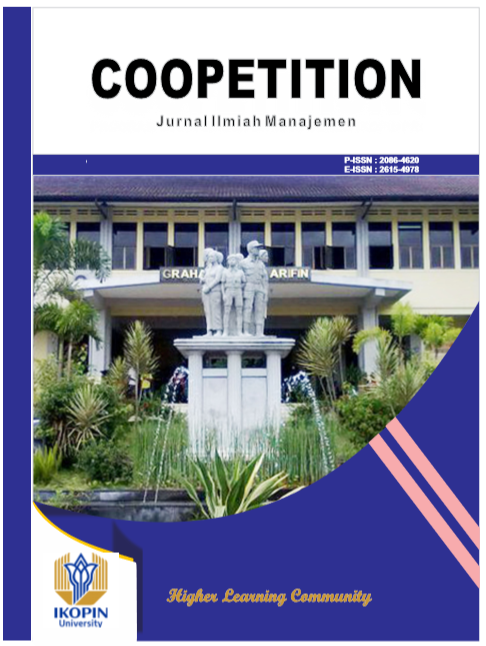Strategi Lokalisasi PKL : Peranan Pemerintah Kabupaten Pamekasan Dalam Meningkatkan Perekonomian Daerah
DOI:
https://doi.org/10.32670/coopetition.v15i2.4402Keywords:
Localization; Street vendors; Regional EconomyAbstract
The aim of this research is to see how the localization strategy for street vendors in Pamekasan district can improve the regional economy. This is not without reason because street vendors are a form of business in the informal sector whose existence has a significant impact on the regional economy and there are efforts from the regional government itself to encourage the informal sector by achieving quite large numbers during its term of office so that this to be sustainable and synergistic. This is certainly not easy considering that there are still many problems that need to be resolved so as to provide mutually beneficial joint solutions. This research is felt urgent to be implemented considering that there is still a lot of "homework" that must be completed. The research object is the street vendor association in Pamekasan district. Qualitative descriptive method used in this research. The sampling technique for street vendors in each community uses techniques purposive sampling. The results of research regarding the localization strategy carried out by the Pamekasan district government were that a special area for street vendors (zoning model) was formed which was spread across several points including: 1. The "Sae Salera" area; 2. The "Sae Rassah" area and 3. The "Food Colony" area. It is hoped that these three areas will become one of the solutions and part of the strategy carried out by the Pamekasan district regional government.
Downloads
References
Agustinus, T. H. (2010). Strategi Penanganan Pedagang Kaki Lima Di Kota Administrasi Jakarta Utara. UI.
Andiny, P., & Kurniawan, A. (2017). Analisis Pendapatan Pedagang Kaki Lima Sebelum Dan Sesudah Program Relokasi Di Kota Langsa. Jurnal Samudra Ekonomika, 1(2), 196. http://ejurnalunsam.id/index.php/jse/article/download/340/260/
Arsyad, L. (2000). Pengantar Perencanaan dan Pembangunan Ekonomi Daerah (Edisi 1 Ce). BPFE Yogyakarta.
Chrisanto, C. A. D. (2014). LOKALISASI ??? Wordpress.Com. https://clararchita77.wordpress.com/2014/04/27/lokalisasi/
Djadjuli, R. D. (2018). Peran Pemerintah Dalam Pembangunan Ekonomi Daerah. Jurnal Dinamika: Jurnal Ilmiah Ilmu Administrasi Negara, Vol 5 (2), hal. 10. https://jurnal.unigal.ac.id/index.php/dinamika/article/view/1409
Djaja, M. H., & Maulana, W. (2020). The role of the du pont system to improve the financial performance of KUD Pamekasan. Equity : Journal of Economics and Finance, 4(3), 353–372. https://doi.org/10.24034/j25485024.y2020.v4.i3.4124
Febrilianawati, A. I. (2010). EFEKTIVITAS KEBIJAKAN RELOKASI PEDAGANG KAKI LIMA (PKL) DI JALAN KI HAJAR DEWANTARA SURAKARTA. In UNS-FISIP Jur. Ilmu Administrasi. Universitas Sebelas Maret.
Feriyanto, N. (2014). Ekonomi sumber daya manusia dalam perspektif indonesia. UPP STIM YKPN.
Hariyani, T. (2019). Pedagang Kaki Lima Sebagai Alternatif Kesempatan Kerja Bagi Kaum Perempuan Di Pedesaan. Ekuivalensi, 5(2), 174–188.
Heriyanto, A. W. (2012). Dampak Sosial Ekonomi Relokasi Pedagang Kaki Lima di Kawasan Simpang Lima dan Jalan Pahlawan Kota Semarang. Economics Development Analysis Journal, 1(2).
Humas Pamekasan. (2020). PROGRAM SEPULUH RIBU WIRAUSAHA BARU (SAPUTANGAN BIRU). Pamekasankab.Go.Id. https://pamekasankab.go.id/berita/194/program-sepuluh-ribu-wirausaha-baru-saputangan-biru
Karim, L. A., Setyawan, D., & Rusmiwari, S. (2014). PENGARUH PENGATURAN TERHADAP PEMBINAAN PEDAGANG KAKI LIMA DI KOTA MALANG. JISIP: Jurnal Ilmu Sosial Dan Ilmu Politik, 3(2), 22–25.
Mochammad Aringga Prasetya, L. F. (2016). DAMPAK SOSIAL EKONOMI RELOKASI PEDAGANG KAKI LIMA DI KECAMATAN BUDURAN KABUPATEN SIDOARJO. JKMP, 4(2), 135–150.
Prasetya, A., & Komara, B. D. (2019). Perlawanan Pedagang Kaki Lima Terhadap Kebijakan Relokasi Pemerintah Daerah. Jurnal Riset Entrepreneurship, 2(2), 1. https://doi.org/10.30587/jre.v2i2.955
Puspitasari, D. E. (2010). Penataan Pedagang Kaki Lima Kuliner untuk Mewujudkan Fungsi Tata Ruang Kota di Kota Yogyakarta dan Kabupaten Sleman. Mimbar Hukum - Fakultas Hukum Universitas Gadjah Mada, 22(3), 588–606.
Ramadhan, A. (2015). Implementasi Model Zonasi Penataan Pedagang Kaki Lima di Kota Bandung. Pandecta: Research Law Journal, 10(1). https://doi.org/10.15294/pandecta.v10i1.4196
Sasongko, D. (2020). UMKM Bangkit, Ekonomi Indonesia Terungkit. DJKN.Kemenkeu.Go.Id. https://www.djkn.kemenkeu.go.id/artikel/baca/13317/UMKM-Bangkit-Ekonomi-Indonesia-Terungkit.html
Setyaningrum, N. A. (2022). Implementasi Kebijakan Pemerintah Dalam Penanganan Pedagang Kaki Lima di Kota Surabaya ( Studi Kasus Pada Pedagang Kaki Lima Kali Rungkut Surabaya ) SKRIPSI Diajukan untuk Melengkapi Tugas Akademik dan Memenuhi Syarat Pencapaian Gelar Sarjana Strata-1 PRO. UNIVERSITAS 17 AGUSTUS 1945 SURABAYA.
Setyowati, H. E. (2020). Melalui KUR, Pemerintah Terus Upayakan Keberpihakan Pada UMKM. Ekon.Go.Id. https://ekon.go.id/publikasi/detail/51/melalui-kur-pemerintah-terus-upayakan-keberpihakan-pada-umkm
Subandi. (2005). Sistem Ekonomi Indonesia (Cetakan 1). Alfabeta.
Downloads
Published
How to Cite
Issue
Section
License
Copyright (c) 2024 Coopetition : Jurnal Ilmiah Manajemen

This work is licensed under a Creative Commons Attribution 4.0 International License.


















